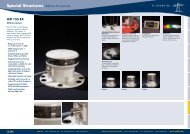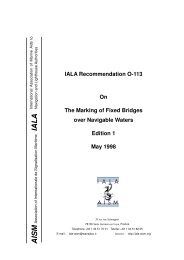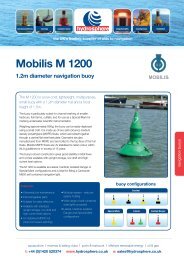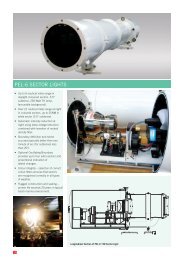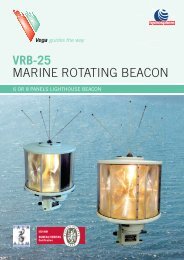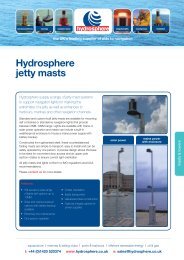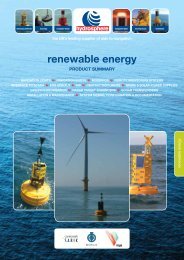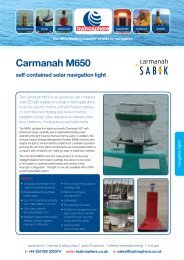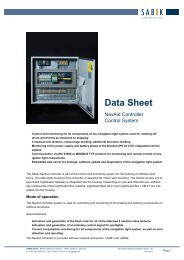Hydrosphere UK Ltd Complete Products & Services Catalogue
Hydrosphere UK Ltd Complete Products & Services Catalogue
Hydrosphere UK Ltd Complete Products & Services Catalogue
Create successful ePaper yourself
Turn your PDF publications into a flip-book with our unique Google optimized e-Paper software.
SINGLE PEL SECTOR LIGHT APPLICATIONS<br />
Mark a Leading Line<br />
This is the most common application for a sector light. The<br />
light can be mounted at any elevation on the desired track,<br />
preferably above street-level background lighting, and in<br />
a secure location. There is complete fl exibility regarding<br />
individual sectors, and sectors need not be symmetrical. For<br />
extra intensity use two lights mounted one above the other.<br />
For very long and narrow channels refer to Parallel Channel<br />
example, as two lights arranged in this way may be required<br />
to give adequate sensitivity at full range.<br />
Supplement a Flashing Beacon (Wellington, NZ)<br />
A small fl ashing beacon (with shadow-type fi lters) projects<br />
light through a large angle, and a PEL Light supplements the<br />
beacon in the direction of interest, by increasing intensity<br />
and sharpening the sector boundaries to defi ne the safe<br />
passage. The harbour entrance has many rocky shoals, and<br />
accurate directional guidance is necessary. In the sector in<br />
which it is visible, the PEL light overpowers the signal from<br />
the fl ashing beacon. Both lights have CALC-2000 controllers<br />
and fl ash in sync.<br />
Flinders Island<br />
Somes<br />
Island<br />
Wellington Harbour<br />
Great Dog<br />
Franklin Sound<br />
Two PEL-6-5D SectorLights<br />
One PEL-3-10D Sector Light<br />
One Flashing Beacon<br />
One PEL-3-10D Sector Light<br />
Mark a Fishing Zone or Marine Reserve<br />
In this example a single line is drawn out perpendicular to the<br />
coast, with a different colour each side of the line. A narrow<br />
subtense produces greater intensity, but viewing angle is<br />
reduced. A PEL-6 light is used, so the signal can be read<br />
both day and night. The light is fl ashed to conserve energy,<br />
as the installation is on a remote piece of coast, and must be<br />
solar powered. The on-period of 2 seconds is the minimum<br />
that can be used with the 250 Watt lamp to allow time for the<br />
lamp to achieve full brilliance.<br />
Mark a River Crossing (USA)<br />
Vessels cross from one side to the other as deep water<br />
follows the outside of bends. Crossings move during<br />
fl oods, and aids often need to be realigned. Rear towers<br />
for transit lights are expensive, especially if they need to be<br />
moved from time to time. A PEL light can be located on the<br />
riverbank, and rotated or repositioned with relative ease. A<br />
PEL-3-3.5D light with automatic night dimming (and coated<br />
optics to extract maximum energy) provides day+night use<br />
over 1-2NM in several solar-powered installations.<br />
Marine Reserve<br />
Crossing<br />
Non Reserve Area<br />
One PEL-6-20D Sector Light<br />
One PEL-3-3.5D Sector Light<br />
(with coated optics)<br />
17



